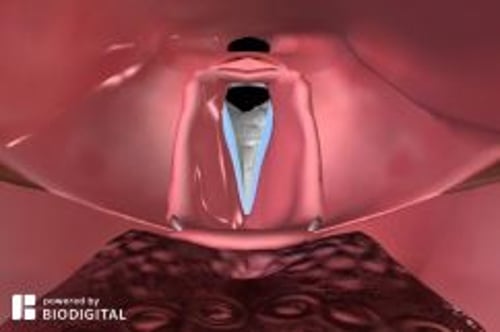Mirror (indirect) laryngoscopy is viewing of the pharynx and larynx using a small, curved mirror.
Topic Resources
Mirror laryngoscopy is typically done to evaluate symptoms in the pharynx and larynx.
(See also Evaluation of the Patient with Nasal and Pharyngeal Symptoms and Overview of Laryngeal Disorders.)
Indications for Mirror Laryngoscopy
Laryngoscopy may be indicated to evaluate
Chronic cough
Dysphagia
Odynophagia
Hoarseness or change in voice
Dysphonia
Chronic throat pain
Sensation of a lump or foreign body in the throat
Symptoms of aspiration
Sometimes hemoptysis
In particular, patients at high risk of head and neck cancer (eg, heavy smokers or alcohol users) may benefit from laryngoscopy, especially if they have had hoarseness, sore throat, or ear pain for > 2 weeks.
Laryngoscopy also may be useful to evaluate the airway prior to orotracheal intubation.
Contraindications to Mirror Laryngoscopy
Absolute contraindications
Suspected epiglottitis
In such cases, stimulation of the laryngopharynx may further compromise the airway. If laryngoscopy is essential, it should be done in the controlled setting of an operating room with a person skilled at difficult airway management (including surgical techniques) present.
Relative contraindications
Stridor
Strong gag reflex
Complications of Mirror Laryngoscopy
Injury to the mucosa, which may cause bleeding
Laryngospasm and airway compromise
The procedure may cause gagging, coughing, and/or vomiting.
Equipment for Mirror Laryngoscopy
Curved dental mirror
Antifogging solution, warm water (about body temperature), or alcohol swab
Headlamp or other external light source that can be used hands-free if possible
Gloves
Protective eyewear
Mask
Gauze pad 10 cm × 10 cm (4 in × 4 in)
Tongue depressor
Topical anesthetic spray (eg, lidocaine, benzocaine)Topical anesthetic spray (eg, lidocaine, benzocaine)
Additional Considerations for Mirror Laryngoscopy
Most patients tolerate mirror laryngoscopy without anesthesia of the oropharynx; however, topical anesthesia may be needed.
If the patient does not tolerate this procedure, flexible laryngoscopy should be done.
Mirror laryngoscopy provides only a limited view of the subglottic larynx and proximal trachea. If pathology is suspected in these regions, use another procedure, such as bronchoscopy.
Relevant Anatomy for Mirror Laryngoscopy
The pharynx includes the nasopharynx, oropharynx, and hypopharynx.
The larynx connects the pharynx to the trachea and is suspended from the hyoid bone. It includes 3 single and 3 paired cartilage structures: single (epiglottis, thyroid, and cricoid) and paired (arytenoid, cuneiform, and corniculate). The larynx extends from the tip of the epiglottis down to the inferior aspect of the cricoid cartilage and includes the vocal folds.
Positioning for Mirror Laryngoscopy
Patient should sit upright with the head against a headrest, and leaning slightly forward, facing the practitioner. The proper position is sometimes called the "sniffing position" because the patient appears to be leaning forward as if to smell a flower.
Legs should not be crossed.
Step-by-Step Description of Mirror Laryngoscopy
Adjust the external light source.
Warm the mirror with warm water (about body temperature) to prevent fogging (check to make sure mirror is not too hot). Alternatively, coat the mirror with antifogging solution or alcohol.
Wrap the patient's tongue with gauze and grasp it with your nondominant hand. The gauze will prevent the tongue from slipping and protect it from injury by the lower incisor teeth.
Gently pull on the tongue.
Instruct the patient to breathe deeply through the mouth, to help prevent gagging.
Slide the mirror into the oropharynx without touching the tongue or any mucosa.
Place the back of the mirror against the uvula and gently insert it further until the larynx can be clearly seen.
If gagging occurs, remove the mirror and spray the posterior oropharynx with a topical anesthetic.
Move the mirror gently and as little as possible to inspect the base of the tongue, valleculae, epiglottis, piriform sinuses, arytenoids, false and true vocal cords, and if possible the larynx below the vocal cords.
Rotate the mirror from side to side with thumb and forefinger to bring lateral structures into view.
Fully inspect the vocal cords. Instruct the patient to say "eeee," which will contract the vocal cords, and assess their function.
Aftercare for Mirror Laryngoscopy
Instruct the patient to avoid eating and drinking for at least 20 minutes to avoid aspiration due to residual laryngopharyngeal anesthesia.
Warnings and Common Errors for Mirror Laryngoscopy
Failure to align the light source as closely as possible with line of sight
Failure to warm the mirror, because a cold mirror will fog
Failure to maintain hold of the patient's tongue to keep it retracted
Allowing the patient to lean back, which will prevent full visualization
Having the mirror at the wrong angle to see the larynx
Tips and Tricks for Mirror Laryngoscopy
To avoid neck strain, raise the patient so that the mirror can be held close to examiner's eye level.
Use one finger of the hand holding the mirror to elevate the upper lip.
Touching the uvula alone should not cause gagging, but avoid touching the back or sides of the throat.


